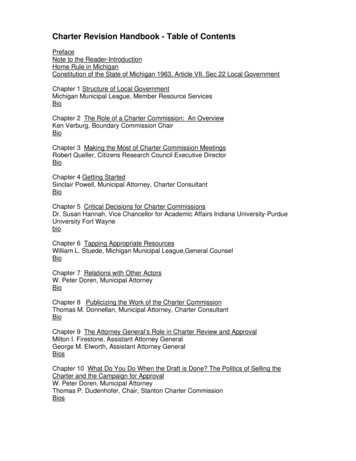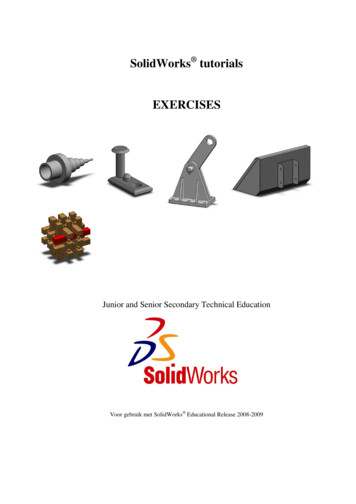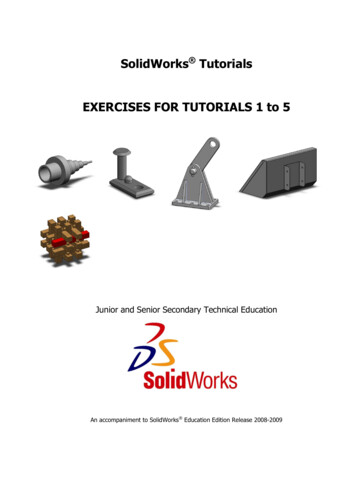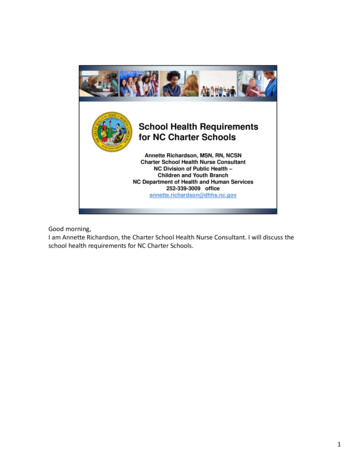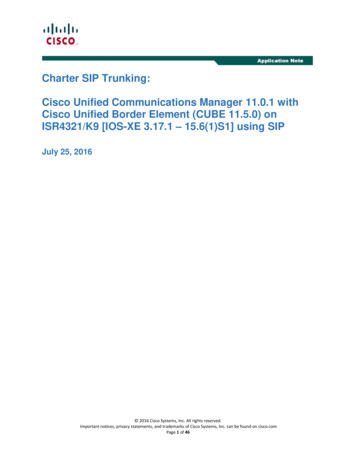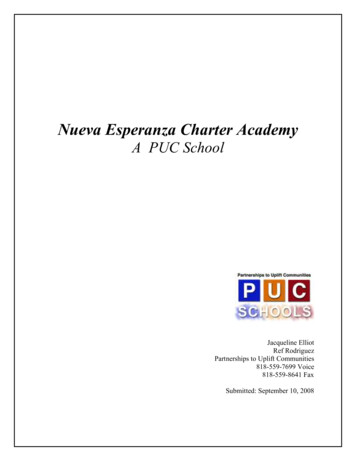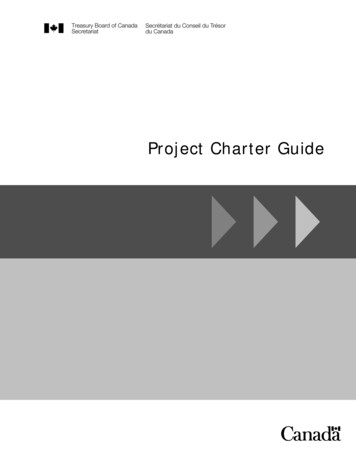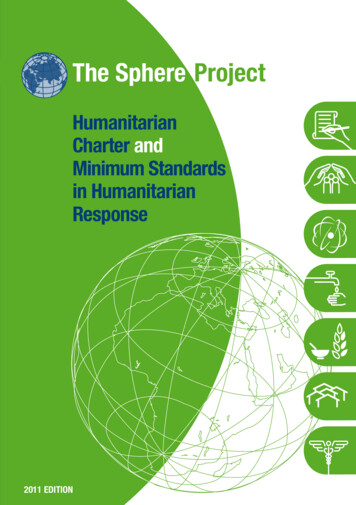
Transcription
The Sphere ProjectHumanitarianCharter andMinimum Standardsin HumanitarianResponse2011 ediTion
The Sphere ProjectHumanitarianCharter andMinimum Standardsin HumanitarianResponse
Published by:The Sphere ProjectCopyright@The Sphere Project 2011Email: info@sphereproject.orgWebsite : www.sphereproject.orgThe Sphere Project was initiated in 1997 by a group of NGOs and the Red Crossand Red Crescent Movement to develop a set of universal minimum standardsin core areas of humanitarian response: the Sphere Handbook. The aim ofthe Handbook is to improve the quality of humanitarian response in situationsof disaster and conflict, and to enhance the accountability of the humanitariansystem to disaster-affected people. The Humanitarian Charter and MinimumStandards in Humanitarian Response are the product of the collective experienceof many people and agencies. They should therefore not be seen as representingthe views of any one agency.First trial edition 1998First final edition 2000Second edition 2004Third edition 2011Second re-print October 2011ISBN 978-1-908176-00-4A catalogue record for this publication is available from The British Library and theUS Library of Congress.All rights reserved. This material is copyright but may be reproduced by anymethod without fee for educational purposes but not for resale. Formal permissionis required for all such uses but normally will be granted immediately. For copyingin other circumstances, for posting online or for reuse in other publications, orfor translation or adaptation, prior written permission must be obtained from thecopyright owner, and a fee may be payable.Distributed for the Sphere Project by Practical Action Publishing and its agentsand representatives throughout the world.Practical Action Publishing, Schumacher Centre for Technology and Development,Bourton on Dunsmore, Rugby, CV23 9QZ, United KingdomTel 44 (0) 1926 634501; Fax 44 (0)1926 634502email: sphere@practicalaction.org.ukwebsite: www.practicalactionpublishing.org/spherePractical Action Publishing (UK Company Reg. No. 1159018) is the wholly ownedpublishing company of Practical Action and trades only in support of its parentcharity objectives.Designed by:, Metz-Tessy, FrancePrinted by: Belmont Press Ltd, Northampton, United Kingdomii
ForewordThis latest edition of the Sphere Handbook, Humanitarian Charter and MinimumStandards in Humanitarian Response, is the product of broad inter-agencycollaboration.The Humanitarian Charter and minimum standards reflect the determination of agencies to improve both the effectiveness of their assistance and theiraccountability to their stakeholders, contributing to a practical framework foraccountability.The Humanitarian Charter and minimum standards will not of course stop humanitarian crises from happening, nor can they prevent human suffering. What theyoffer, however, is an opportunity for the enhancement of assistance with the aimof making a difference to the lives of people affected by disaster.From their origin in the late 1990s, as an initiative of a group of humanitarianNGOs and the Red Cross and Red Crescent Movement, the Sphere standardsare now applied as the de facto standards in humanitarian response in the 21stcentury.A word of gratitude must, therefore, be given to all those who have made thishappen.Ton van ZutphenSphere Board ChairJohn DamerellProject Manageriii
Humanitarian Charter and Minimum Standards in Humanitarian ResponseAcknowledgementsThe revision of the Sphere Handbook has been an extensive, collaborative andconsultative process, engaging a considerable number of people around theworld – too many to mention individually by name. The Sphere Project acknowledges the breadth of the contributions made and the willingness of organisationsand individuals to be involved.The Handbook revision process was led by a group of focal points for the technicalchapters and cross-cutting themes, supported by resource persons for emergingissues, all drawn from the sector, either seconded from humanitarian organisations or directly hired, depending on the level of work envisaged. Consultantsled the revision of elements relevant for the Handbook as a whole, and whichrequired substantial new work. Where not stated otherwise, the people listedbelow were consultants.Humanitarian Charter: James Darcy, Mary Picard, Jim Bishop (InterAction),Clare Smith (CARE International) and Yvonne Klynman (IFRC)Protection Principles: Ed Schenkenberg van Mierop (ICVA) and Claudine HaenniDaleCore Standards: Peta Sandison and Sara DavidsonTechnical chapters Water supply, sanitation and hygiene promotion: Nega Bazezew Legesse(Oxfam GB) Food security and nutrition:-- Nutrition: Susan Thurstans (Save the Children UK)-- Food security and livelihoods: Devrig Velly (Action contre la Faim)-- Food aid: Paul Turnbull (WFP) and Walter Middleton (World VisionInternational)iv Shelter, settlement and non-food items: Graham Saunders (IFRC) Health action: Mesfin Teklu (World Vision International)
AcknowledgementsCross-cutting themes Children: Monica Blomström and Mari Mörth (both Save the ChildrenSweden) Older people: Jo Wells (HelpAge International) Persons with disabilities: Maria Kett (Leonard Cheshire Disability andInclusive Development Centre) Gender: Siobhán Foran (IASC GenCap Project) Psychosocial issues: Mark van Ommeren (WHO) and Mike Wessells(Columbia University) HIV and AIDS: Paul Spiegel (UNHCR) Environment, climate change and disaster risk reduction: Anita vanBreda (WWF) and Nigel Timmins (Christian Aid)Sphere companion standards Education: Jennifer Hofmann and Tzvetomira Laub (both INEE) Livestock: Cathy Watson (LEGS) Economic recovery: Tracy Gerstle and Laura Meissner (both SEEP network)Resource persons Early recovery: Maria Olga Gonzalez (UNDP-BCPR) Camp coordination and camp management: Gillian Dunn (IRC) Cash transfer programming: Nupur Kukrety (Cash Learning Partnershipnetwork)In addition, a number of people were consulted with regard to the civil–militaryinterface, conflict sensitivity and urban settings.Working groups and reference groups were established to support the focalpoints in their work; while The Sphere Project acknowledges the contribution ofall these persons, their individual names are not included herein. However, a fulllisting of all working group and reference group members can be found on theSphere website: www.sphereproject.org.Editors: Phil Greaney, Sue Pfiffner, David WilsonRevision workshop facilitator: Raja JarrahMonitoring and evaluation specialist: Claudia Schneider, SKATv
Humanitarian Charter and Minimum Standards in Humanitarian ResponseSphere Board (as at 31 December 2010)Action by Churches Together (ACT) Alliance (John Nduna) * Agency CoordinatingBody for Afghan Relief (ACBAR) (Laurent Saillard) * Aktion Deutschland Hilft(ADH) (Manuela Rossbach) * CARE International (Olivier Braunsteffer) * CARITASInternationalis (Jan Weuts) * The International Council of Voluntary Agencies(ICVA) (Ed Schenkenberg van Mierop) * International Rescue Committee (IRC)(Gillian Dunn) * InterAction (Linda Poteat) * Intermón Oxfam (Elena Sgorbati) *International Federation of Red Cross and Red Crescent Societies (IFRC) (SimonEccleshall) * The Lutheran World Federation (LWF) (Rudelmar Bueno de Faria)* Policy Action Group on Emergency Response (PAGER) (Mia Vukojevic) *Plan International (Unni Krishnan) * Save the Children Alliance (Annie Foster) *Sphere India (N.M. Prusty) * The Salvation Army (Raelton Gibbs) * World VisionInternational (Ton van Zutphen)DonorsIn addition to contributions by the Board organisations listed above, funding forthe Handbook revision process was provided by:Australian Agency for International Development (AusAID) * European CommunityHumanitarian Office (ECHO) * German Ministry of Foreign Affairs * SpanishMinistry of Foreign Affairs * Swiss Agency for Development and Cooperation(SDC) * United Kingdom Department for International Development (DFID) *United States Department of State Bureau of Refugees and Migration (US-PRM) *United States Agency for International Development Office of Foreign DisasterAssistance (US-OFDA)Sphere Project staff teamProject Manager: John DamerellTraining and Learning Management: Verónica FoubertPromotion and Materials Management: Aninia NadigTraining and Promotion Support: Cécilia FurtadeAdministration and Finance: Lydia BeauquisAt various stages during the Handbook revision process, additional team supportwas provided by Alison Joyner, Hani Eskandar and Laura Lopez.vi
ContentsForeword iiiAcknowledgements ivWhat is Sphere? 3The Humanitarian Charter 19Protection Principles 25The Core Standards 49Minimum standards in Water Supply, Sanitation and Hygiene Promotion 79Minimum standards in food security and nutrition 139Minimum Standards in Shelter, Settlement and Non-Food Items 239Minimum standards in health action 287Annexes 355Annex 1. Key Documents that inform the Humanitarian Charter 356Annex 2. The Code of Conduct for the International Red Cross andRed Crescent Movement and Non-Governmental Organisations(NGOs) in Disaster Relief 368Annex 3. A bbreviations and Acronyms 377Index 3811
Humanitarian Charter and Minimum Standards in Humanitarian ResponseThe HandbookWhat is Sphere?Humanitarian CharterProtection principlesPrinciples andCore StandardsCore standardsThe CoreStandardsand minimumstandards:Principlesput intopracticeWater Supply, Sanitationand Hygiene PromotionFood Security and NutritionShelter, Settlementand Non-Food ItemsHealth ActionKey Documents that informthe Humanitarian CharterCode of Conduct2Each chapter containsa set of standards, aswell as appendicesand references/further reading.Standard structure:Minimum standardKey actionsKey indicatorsGuidance notes
What is Sphere?3
Humanitarian Charter and Minimum Standards in Humanitarian ResponseWhat is Sphere?The Sphere Project and its Handbook are well known for introducing considerations of quality and accountability to humanitarian response. But what arethe origins of the Sphere Project? What are its philosophy and approach? Howand why was this Handbook conceived? What is its place in the wider realmof humanitarian action? And who should use it and when? This chapter strivesto provide some answers to these key questions. Furthermore, it details theHandbook structure and explains how to use it and how you or your organisationcan conform to the Sphere minimum standards.The Sphere Project philosophy: The right to lifewith dignityThe Sphere Project – or ‘Sphere’ – was initiated in 1997 by a group of humanitarian non-governmental organisations (NGOs) and the International Red Crossand Red Crescent Movement. Their aim was to improve the quality of their actionsduring disaster response and to be held accountable for them. They basedSphere’s philosophy on two core beliefs: first, that those affected by disasteror conflict have a right to life with dignity and, therefore, a right to assistance;and second, that all possible steps should be taken to alleviate human sufferingarising out of disaster or conflict.Striving to support these two core beliefs, the Sphere Project framed aHumanitarian Charter and identified a set of minimum standards in key lifesaving sectors which are now reflected in the Handbook’s four technical chapters:water supply, sanitation and hygiene promotion; food security and nutrition;shelter, settlement and non-food items; and health action. The Core Standardsare process standards and apply to all technical chapters.The minimum standards are evidence-based and represent sector-wideconsensus on best practice in humanitarian response. Key actions, keyindicators and guidance notes (described in the ‘How to use the standards’section below) accompany each standard, providing guidance on how to attainthe standard.4
What is Sphere?The minimum standards describe conditions that must be achieved in anyhumanitarian response in order for disaster-affected populations to survive andrecover in stable conditions and with dignity. The inclusion of affected populations in the consultative process lies at the heart of Sphere’s philosophy. TheSphere Project, consequently, was one of the first of what are now known as thequality and accountability (Q&A) initiatives.The Humanitarian Charter and the minimum standards are published togetheras a Handbook, the latest edition of which you are reading now. The SphereHandbook is designed for planning, implementation, monitoring and evaluationduring humanitarian response. It is also an effective advocacy tool when negotiating for humanitarian space and for the provision of resources with authorities. Furthermore, it is useful for disaster preparedness activities and contingencyplanning, with donors increasingly including the standards in their reportingrequirements.Because it is not owned by any one organisation, the Handbook enjoys broadacceptance by the humanitarian sector as a whole. It has become one of the mostwidely known and internationally recognised sets of standards for humanitarianresponse and is used as an inter-agency communication and coordination tool.First published in 2000, the Handbook was revised in 2003 and again in 2009–2010. During each revision process, sector-wide consultations were conducted,involving a wide range of agencies, organisations and individuals, includinggovernments and United Nations (UN) agencies.The principal users of the Sphere Handbook are practitioners involved inplanning, managing or implementing a humanitarian response. This includes staffand volunteers of local, national and international humanitarian agencies. In thecontext of fund-raising and project proposals, the minimum standards are alsofrequently referred to.Other actors, such as government and local authorities, the military or the privatesector, are also encouraged to use the Sphere Handbook. It may be useful inguiding their own actions, but also in helping them to understand the standardsused by the humanitarian agencies with whom they may interact.The Handbook: A reflection of Sphere’s valuesThe Handbook structure reflects Sphere’s aim to firmly anchor humanitarianresponse in a rights-based and participatory approach.5
Humanitarian Charter and Minimum Standards in Humanitarian ResponseHumanitarian Charter, Protection Principles and Core StandardsThe Humanitarian Charter, the Protection Principles and the Core Standardsarticulate Sphere’s rights-based and people-centred approach to humanitarianresponse. They focus on the importance of including the affected populationand local and national authorities at all stages of the response. The ProtectionPrinciples and Core Standards are grouped together at the beginning of theHandbook so as to avoid repeating them in each technical chapter. Sphere users,including specialists in one particular technical area, must consider them as anintegral part of these chapters.The cornerstone of the Handbook is the Humanitarian Charter (accompaniedby a descriptive list of key legal and policy documents in Annex 1 on page 356).It provides the ethical and legal backdrop to the Protection Principles, as well asto the Core Standards and minimum standards, thereby setting the stage fortheir correct interpretation and implementation. It is a statement of establishedlegal rights and obligations and of shared beliefs and commitments of humanitarian agencies, all collected in a set of common principles, rights and duties.Founded on the principle of humanity and the humanitarian imperative, theseinclude the right to life with dignity, the right to receive humanitarian assistance andthe right to protection and security. The Charter also emphasises the importanceof agency accountability to affected communities. The Core Standards andminimum standards are an articulation of what these principles and obligationsmean in practice.The Humanitarian Charter explains why both assistance and protection arecritical pillars of humanitarian action. To further develop this protection aspect,the Handbook includes a set of Protection Principles, which translates severalof the legal principles and rights outlined in the Charter into strategies andactions that should inform humanitarian practice from a protection perspective.Protection is a core part of humanitarian action and the Protection Principlespoint to the responsibility of all humanitarian agencies to ensure that their activities are concerned with the more severe threats that affected people commonlyface in times of conflict or disaster.All humanitarian agencies should ensure that their actions do not bring furtherharm to affected people (Protection Principle 1), that their activities benefit inparticular those who are most affected and vulnerable (Protection Principle 2),that they contribute to protecting affected people from violence and other humanrights abuses (Protection Principle 3) and that they help affected people recoverfrom abuses (Protection Principle 4). The roles and responsibilities of humanitarian agencies in protection are, generally, secondary to the legal responsibilityof the state or other relevant authorities. Protection often involves reminding theseauthorities of their responsibilities.6
What is Sphere?The Core Standards are the first set of minimum standards and inform all others.They describe how the processes and approaches taken during a humanitarianresponse are fundamental to an effective response. A focus on the capacity andactive participation of those affected by disaster or conflict, a comprehensiveanalysis and understanding of needs and context, effective coordination amongagencies, a commitment to continually improving performance, and appropriatelyskilled and supported aid workers are all essential in order to attain the technicalstandards.The Protection Principles and Core Standards are grouped together at the beginning of the Handbook so as to avoid repeating them in each technical chapter.They underpin all humanitarian activity and must be used in conjunction withthe technical chapters. They are critical to achieving the technical standards ina spirit of quality and accountability to the affected populations.The Core Standards and the minimum standards in four technical chaptersThe Core Standards and minimum standards cover approaches to programming and four sets of life-saving activities: water supply, sanitation and hygienepromotion; food security and nutrition; shelter, settlement and non-food items;and health action.How to use the standardsThe Core Standards and minimum standards follow a specific format. They beginwith a general and universal statement – the minimum standard – followed by aseries of key actions, key indicators and guidance notes.First, the minimum standard is stated. Each standard is derived from the principle that disaster-affected populations have the right to life with dignity. They arequalitative in nature and specify the minimum levels to be attained in humanitarianresponse. Their scope is universal and applicable in any disaster situation. Theyare, therefore, formulated in general terms.Next, practical key actions are suggested, to attain the minimum standard.Some actions may not be applicable in all contexts, and it is up to the practitionerto select the relevant actions and devise alternative actions that will result in thestandard being met.Then, a set of key indicators serves as ‘signals’ that show whether a standardhas been attained. They provide a way of measuring and communicating theprocesses and results of key actions. The key indicators relate to the minimumstandard, not to the key action.7
Humanitarian Charter and Minimum Standards in Humanitarian ResponseFinally, guidance notes include context-specific points to consider when aimingat reaching the key actions and key indicators. They provide guidance on tacklingpractical difficulties, benchmarks or advice on priority and cross-cutting themes.They may also include critical issues relating to the standards, actions or indicators and describe dilemmas, controversies or gaps in current knowledge. Theydo not provide guidance as to how to implement a specific activity.Brief introductions to each chapter set out the major relevant issues. Thetechnical minimum standards chapters further contain appendices including,for example, assessment checklists, formulas, tables and examples of reportforms. Each chapter ends with references and suggestions for further reading. Adetailed glossary for each of the Handbook chapters is available on the Spherewebsite (www.sphereproject.org).All the chapters are interconnected. Frequently, standards described in onesector need to be addressed in conjunction with standards described in others.As a result, the Handbook contains numerous cross-references.Conforming with the Sphere minimum standardsThe Sphere Handbook is a voluntary code and a self-regulatory tool for qualityand accountability, and the Sphere Project does not operate any compliancemechanism. There is no such thing as ‘signing up’ to Sphere, a Sphere membership or any process of accreditation. The Sphere Project has consciously optedfor the Handbook not to be prescriptive or compliance-oriented, in order toencourage the broadest possible ownership of the Handbook.The Handbook does not offer practical guidance on how to provide certainservices (the key actions suggest activities to reach a standard without specifyinghow to do that). Rather, it explains what needs to be in place in order to ensure alife with dignity for the affected population. It is, therefore, up to each implementingagency to choose a system to ensure conformance with the Sphere minimumstandards. Some agencies have used purely internal mechanisms, while othershave opted for peer review. Some agency networks have used Sphere to evaluatetheir collective response in particular emergencies.Conforming with Sphere does not mean meeting all the standards and indicators. The degree to which agencies can meet standards will depend on arange of factors, some of which are outside their control. Sometimes difficultiesof access to the affected population, lack of cooperation from the authorities orsevere insecurity make standards impossible to meet.8
What is Sphere?If the general living conditions of an affected population were already significantlybelow the minimum standards before the disaster, agencies may have insufficientresources to meet the standards. In such situations, providing basic facilities forthe entire affected population may be more important than reaching the minimumstandards for only a proportion.Sometimes the minimum standards may exceed everyday living conditions forthe surrounding population. Adhering to the standards for disaster-affectedpopulations remains essential. But such situations may also indicate the need foraction in support of the surrounding population and for dialogue with communityleaders. What is appropriate and feasible will depend on the context.In cases where the standards cannot be met, humanitarian agencies should:-- describe in their reports (assessment, evaluation, etc.) the gap betweenthe relevant Sphere indicators and the ones reached in practice-- explain the reasons for this and what needs to be changed-- assess the negative implications for the affected population-- take appropriate mitigating actions to minimise the harm caused by theseimplications.By committing to the above steps, agencies demonstrate that they are conformingwith Sphere’s philosophy and its minimum standards even if they are unable tomeet them as set out in the Handbook.The place of Sphere within humanitarian actionThe Sphere Handbook is designed for use during humanitarian response in arange of situations including natural disasters, conflict, slow- and rapid-onsetevents, rural and urban environments, and complex political emergencies in allcountries. The term ‘disaster’ encompasses these situations, and where appropriate, the term ‘conflict’ is used. ‘Population’ refers to individuals, families,communities and broader groups. Consequently, we commonly use ‘disasteraffected population’ throughout the Handbook.When to use this HandbookFocusing on the period of humanitarian response, the Sphere minimum standards cover activities which meet the urgent survival needs of disaster-affectedpopulations. This phase can range from a few days or weeks to many months andeven years, particularly in contexts involving protracted insecurity and displacement. It is, therefore, impossible to assign a particular timeframe to the usefulnessof the Sphere standards.9
Humanitarian Charter and Minimum Standards in Humanitarian ResponseThe Handbook does, however, have a specific place within the broader realm ofhumanitarian action, which goes beyond providing immediate relief and coversa spectrum of activities that starts with disaster preparedness, then includeshumanitarian response, and finally extends into early recovery. As a referencetool, the Handbook is useful in both the disaster preparedness and the earlyrecovery phases which conceptually ‘frame’ humanitarian response but in realityneed to be considered simultaneously.Disaster preparedness requires that actors – governments, humanitarianagencies, local civil society organisations, communities and individuals – have thecapacities, relationships and knowledge to prepare for and respond effectively todisaster or conflict. Before and during a response, they should start taking actionsthat will improve preparedness and reduce risk for the future. They should beprepared, at least, to meet the Sphere minimum standards during a future disaster.Early recovery is the process following relief and leading into long-term recoveryand is most effective if anticipated and facilitated from the very outset of a humanitarian response. Recognising the importance of early recovery, the Handbookmakes reference to it throughout and as appropriate.Developments in the humanitarian sector and their implications for SphereA number of developments in the humanitarian sector and other relevant areashave arisen over the past few years, encompassing changes in the nature ofdisasters and conflicts, as well as of humanitarian work. The developmentsconsidered during the Handbook revision process include:-- a growing conceptual and operational focus on local and nationalresponses with the awareness that affected populations must beconsulted and the response capacities of the crisis-affected state andnational agencies and institutions must be reinforced-- more proactive accountability of humanitarian action, in particular accountability to affected populations, but also more proactive coordination,including within the humanitarian reform process (cluster approach), underthe auspices of the Inter-Agency Standing Committee (IASC)-- an increased focus on protection issues and responses-- increasing awareness of potentially large-scale forced migration due toclimate change-induced disasters and an awareness that environmentaldegradation increases vulnerability-- the recognition that poor urban populations are growing rapidly andthat they have specific vulnerabilities, in particular related to the moneyeconomy, social cohesion and physical space10
What is Sphere?-- new approaches to aid, such as cash and voucher transfers and localpurchases replacing in-kind shipments of humanitarian assistance-- an increased recognition of disaster risk reduction as both a sector andan approach-- an increased involvement of the military in humanitarian response, a setof actors not primarily driven by the humanitarian imperative, requiring thedevelopment of specific guidelines and coordination strategies for humanitarian civil–military dialogue-- an increased involvement of the private sector in humanitarian responserequiring similar guidelines and strategies as the civil–military dialogue.The Sphere Project includes these developments in the Handbook as appropriate – in particular the emerging issues of cash transfers, early recovery andcivil–military relations.Understanding the context during humanitarian responseEffective humanitarian response must be based on a comprehensive, contextualised diagnosis (assessment, monitoring and evaluation), in order to analysepeople’s needs, vulnerabilities and capacities in each context.The Handbook is essentially designed as a tool to recognise different contextsand to adapt response programmes accordingly: it guides practitioners in theirreflections around reaching a universally applicable standard in a concrete situation or context, with part
The Sphere Project was initiated in 1997 by a group of NGOs and the Red Cross and Red Crescent Movement to develop a set of universal minimum standards in core areas of hum
